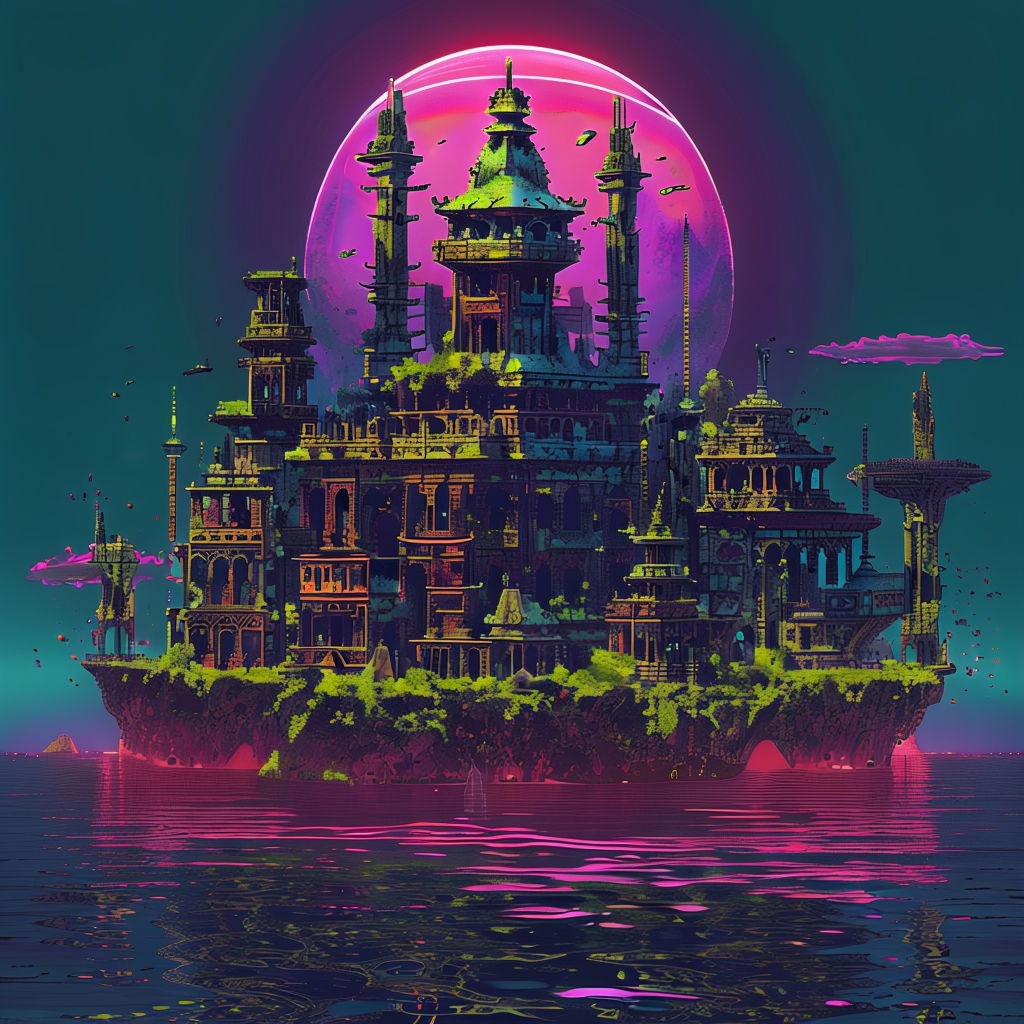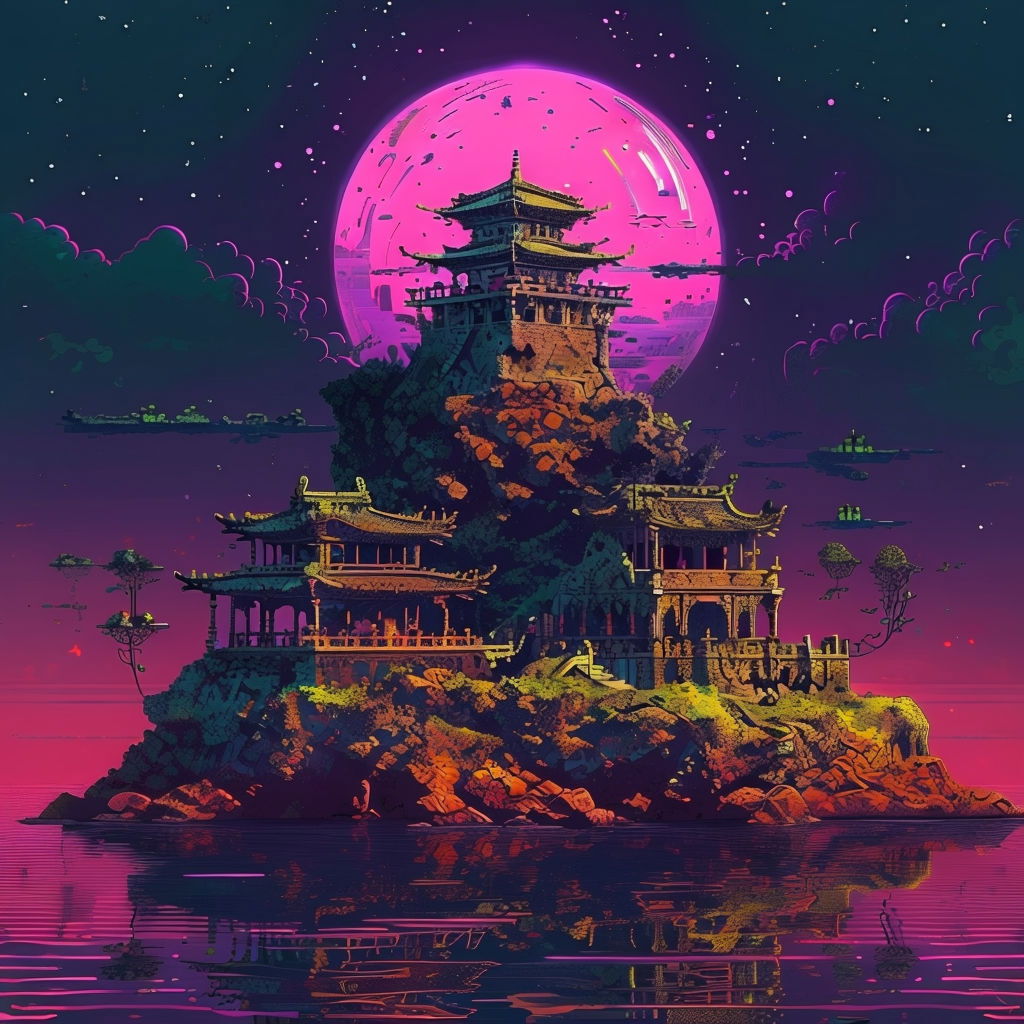Cyber Oasis : A Futuristic Escape to Bronzepunk Crete
The Neo-Minoan Utopia: The Ultimate Bronzepunk Holiday Haven on Crete

In the not-so-distant future, the Minoan civilization has resurfaced, merging ancient grandeur with futuristic bronzepunk aesthetics to create a one-of-a-kind utopia on the island of Crete. This Neo-Minoan society, shimmering under neon lights, is a dazzling paradise where tradition and advanced technology blend seamlessly, offering an irresistible escape from the fast-paced cyberpunk world beyond its shores. Crete has become a sanctuary of luxury, mystery, and elegance—a haven where myth and technology intertwine.
The Revival of Minoan Glory
The Neo-Minoan utopia emerges as a fascinating resurrection of ancient Crete, reviving its unique traditions and aesthetics while infusing them with a high-tech edge. The architecture pays homage to the historical palaces of Knossos and Phaistos, but instead of mere stone and plaster, the structures are fortified with lightweight bronze alloys and shimmering gold, exuding strength and opulence. The walls are adorned with neon-infused Cretan hieroglyphs that glow in the dark, each symbol pulsating like a living code, granting the island an otherworldly beauty by night. In this reimagined Crete, ancient frescoes depicting dolphins, priestesses, and mythical beasts animate with holographic projections, bringing mythological scenes to life as if they were breathing.
The Island of Crete as a Luxury Cyber-Oasis
The reawakened Minoan civilization stands as an idyllic holiday destination, where visitors from across the cyberpunk megacities flock to experience the immersive magic and splendor of a bygone world reborn. Here, the beaches glisten under an artificial sun, and opulent hotels tower over the landscape, designed with intricate bronze frameworks and gold accents that reflect Crete’s historic wealth. Grand pillars and mosaics evoke the elegance of the old world, while the interiors of each building are seamlessly integrated with the latest smart technology, offering unparalleled luxury and convenience.
Transportation around the island is equally revolutionary; people glide through streets in silent, bronze-clad hover carriages, each vehicle adorned with detailed engravings reminiscent of ancient Minoan art. These carriages are equipped with AI guides who offer narrated journeys through the island’s history, explaining each landmark as visitors pass by, from the Palace of Knossos to the fabled labyrinth.
A Society Led by the Snake Goddess: High Priestess of the Future
At the core of Neo-Minoan culture is the Snake Goddess, the revered symbol of the island. In this futuristic era, she is more than an icon—she is the ruling figure, a digital overseer infused with artificial intelligence and powerful magic. The Snake Goddess manifests as a holographic deity, projected in various public squares and temples, her figure clothed in iridescent robes and arms raised, serpents coiled around them, symbolizing wisdom, rebirth, and the mysterious force governing the island. Her presence is both physical and virtual, her image rippling in the form of countless micro-projections around Crete.
The people revere her as both a goddess and a protector, and her wisdom guides every aspect of society. Her digital consciousness is intertwined with the island's infrastructure, regulating resources, overseeing security, and offering counsel to the citizens. With the power to communicate directly with each inhabitant through virtual interactions, the Snake Goddess has become the very embodiment of bronzepunk magic and technology—a figure who watches over and nurtures the island with both ancient wisdom and futuristic knowledge.

The Magic of Cretan Hieroglyphs: Technology Meets Tradition
One of the most enchanting elements of this Neo-Minoan utopia is its mystical writing system. Cretan hieroglyphs, once etched into clay and stone, now shimmer as intricate neon symbols that adorn every corner of the island. Each hieroglyph is more than an aesthetic choice—it serves a functional purpose, blending magic and technology to power everything from streetlights to medical centers. The hieroglyphs act as a hybrid language of symbols and circuits, creating an intelligent network that binds the island’s energy grid. Powered by a renewable source tapping into the natural geothermal energy of Crete, the neon hieroglyphs are the lifeblood of the island, casting a magical glow across the landscape.
Visitors often marvel at the hieroglyphic symbols that seem to respond to their touch, lighting up or rearranging themselves to reveal new meanings and functions. This system has created an immersive experience where the boundaries between myth and reality blur, and everyone who visits Crete leaves feeling as though they have stepped into a dream.
Rituals and Festivals: Celebrating Neo-Minoan Culture
While technology has reshaped daily life in the Neo-Minoan world, the island has preserved its rich cultural heritage through a series of grand festivals and rituals. Each year, Crete hosts the Festival of the Snake Goddess, a spectacular celebration where participants dress in futuristic versions of traditional Minoan attire, their garments adorned with gold and bronze filigree and glowing hieroglyphic patterns. Dancers perform ancient rites, reenacting the mythic tales of gods, heroes, and mythical creatures under the neon-lit temples.
The Festival of the Labyrinth is another key event, where visitors explore a high-tech rendition of the legendary Minoan labyrinth, which is both a physical and virtual maze. Participants navigate through layers of holographic illusions and augmented reality challenges, immersing themselves in a world where mythological monsters and spirits seem to spring to life. This event has become a major draw for thrill-seekers and historians alike, offering an experience that bridges the realms of ancient legend and futuristic adventure.
Advanced Technology and Infrastructure
In addition to its cultural richness, Crete is celebrated for its cutting-edge infrastructure and sustainable technology. Each building on the island is equipped with adaptive lighting that shifts between daylight and night modes, casting the island in a surreal, warm glow that keeps it ever-beautiful and ecologically responsible. Power comes from a mix of solar and geothermal energy, harnessed in innovative ways that harmonize with the natural landscape.
Healthcare and public services are streamlined, with hospitals and wellness centers run by medical AIs designed to administer advanced treatments infused with the therapeutic properties of ancient herbs. This Neo-Minoan medical system combines holistic treatments inspired by ancient Cretan practices with advanced biotech solutions, creating a truly unique approach to healthcare.
Public spaces are embedded with VR and AR interfaces, allowing inhabitants and tourists to experience layers of Cretan history in real-time, transforming the island into a live museum. Museums, temples, and historical sites are embedded with augmented reality displays, guiding visitors through immersive, narrated journeys into the island’s past while projecting visions of its mythical figures.

A Bronzepunk Refuge in a Cyberpunk World
What sets Crete apart in this cyberpunk world is its rejection of the bleak, dystopian elements that pervade the global metropolises. Where cyberpunk cities are dark and filled with neon lights amidst rain-slicked streets, Crete is radiant, basking in the warm glow of its bronzepunk aesthetic. Here, life is slower, more refined, and inspired by values of harmony, beauty, and spirituality.
Crete has established itself as a refuge from the gritty cyberpunk realities beyond its shores, attracting people who long for a life beyond surveillance, corporate control, and ceaseless technological overload. It is a place where one can lose themselves in myth, engage with an intelligent landscape, and marvel at the seamless blend of ancient wisdom and modern marvel.
Final Thoughts: The Neo-Minoan Legacy
In this Neo-Minoan utopia, Crete has become more than a place to visit; it is a pilgrimage to a realm where past and future collide in radiant beauty. It is a sanctuary where the Snake Goddess rules, the hieroglyphs pulse with life, and the essence of ancient Crete is celebrated in a dazzling synthesis of tradition and innovation. The Neo-Minoan legacy on Crete offers more than luxury and escapism—it embodies a new way of living, honoring the wisdom of the past while embracing the potential of the future.
The Island of Transformation: A Sanctuary for the Soul
For many who journey to this bronzepunk haven, the experience of Crete is transformative. Amid the structured chaos of a cyberpunk world, where technology is often isolating and relentless, Crete offers a sanctuary for the soul. Here, technology serves not to alienate but to connect, to uplift, and to inspire awe. Visitors find a space where ancient rituals and modern comforts create a balance that resonates deeply with their own longing for meaning and grounding.
The influence of the Snake Goddess extends beyond the island’s borders, becoming a symbol for a new way of life. Her teachings—interpreted through myth, digital counsel, and the island’s living hieroglyphs—remind people of the importance of connection, reverence for nature, and respect for the unseen forces that shape existence. Her presence on Crete represents an alternative future, where spirituality and technology are not opposing forces but complementary paths to a harmonious society.
Neo-Minoan Crete as a Model of Sustainable Bronzepunk Culture
The Neo-Minoan society has mastered sustainability, not only through its energy sources but in its reverence for materials, its mindful approach to construction, and its seamless integration with the natural landscape. The island’s infrastructure does not seek to dominate the environment but instead aligns with it, echoing the Minoans' deep connection to the land and sea. From its geothermal plants to its solar farms discreetly hidden within the labyrinthine hillsides, Crete stands as a bronzepunk model for a sustainable future that respects heritage and ecological balance.
This attention to sustainability has made Crete a leader in bronzepunk technology exports. The island’s engineers and artisans produce goods that are as much art as they are technology: wearable devices made of bronze and infused with hieroglyphic circuits, self-sustaining biomes that draw on ancient agricultural wisdom, and intricate mechanical devices that mimic the natural rhythms of life. By drawing on the island’s unique cultural perspective, Neo-Minoan Crete has become an exporter of not only technology but a philosophy that has begun to influence cities beyond the Mediterranean.
A Legacy That Lives On: Crete as a Beacon of Hope

As this bronzepunk utopia flourishes, it sparks a renewed interest in ancient civilizations and forgotten traditions. Scholars, artists, and philosophers from across the world are drawn to Crete to learn, be inspired, and engage with the Neo-Minoan way of life. The island’s academies and temples become centers of cultural exchange, fostering a dialogue between past and future, East and West, science and magic.
The Neo-Minoan Crete stands as a beacon of hope, proving that societies can look to the past without regressing, that they can advance without losing their roots. This reborn civilization has transformed the Snake Goddess from a mysterious icon to a guiding force, her image and influence echoing across time, weaving a narrative of resilience, beauty, and wisdom that resonates with the people of Crete and beyond.
In the end, the Neo-Minoan utopia is more than an experiment in bronzepunk aesthetics—it is a testament to the enduring power of myth and memory. Crete’s revival in this future world is a reminder that history does not have to be buried in the sands of time. Instead, it can be reimagined, reinterpreted, and resurrected, offering new generations a place to discover not only the mysteries of the ancient world but a path forward that respects both the sanctity of tradition and the promise of progress.
The island of Crete, glowing under the benevolent gaze of the Snake Goddess and vibrant with neon hieroglyphs, becomes a living legend—a world where myth and technology dance in harmony, and where the past guides the future in a luminous, bronzepunk tapestry of wonder and possibility.
CYBERPUNK FUTURE HOLIDAY ARTICLE BY TEGEDAO!